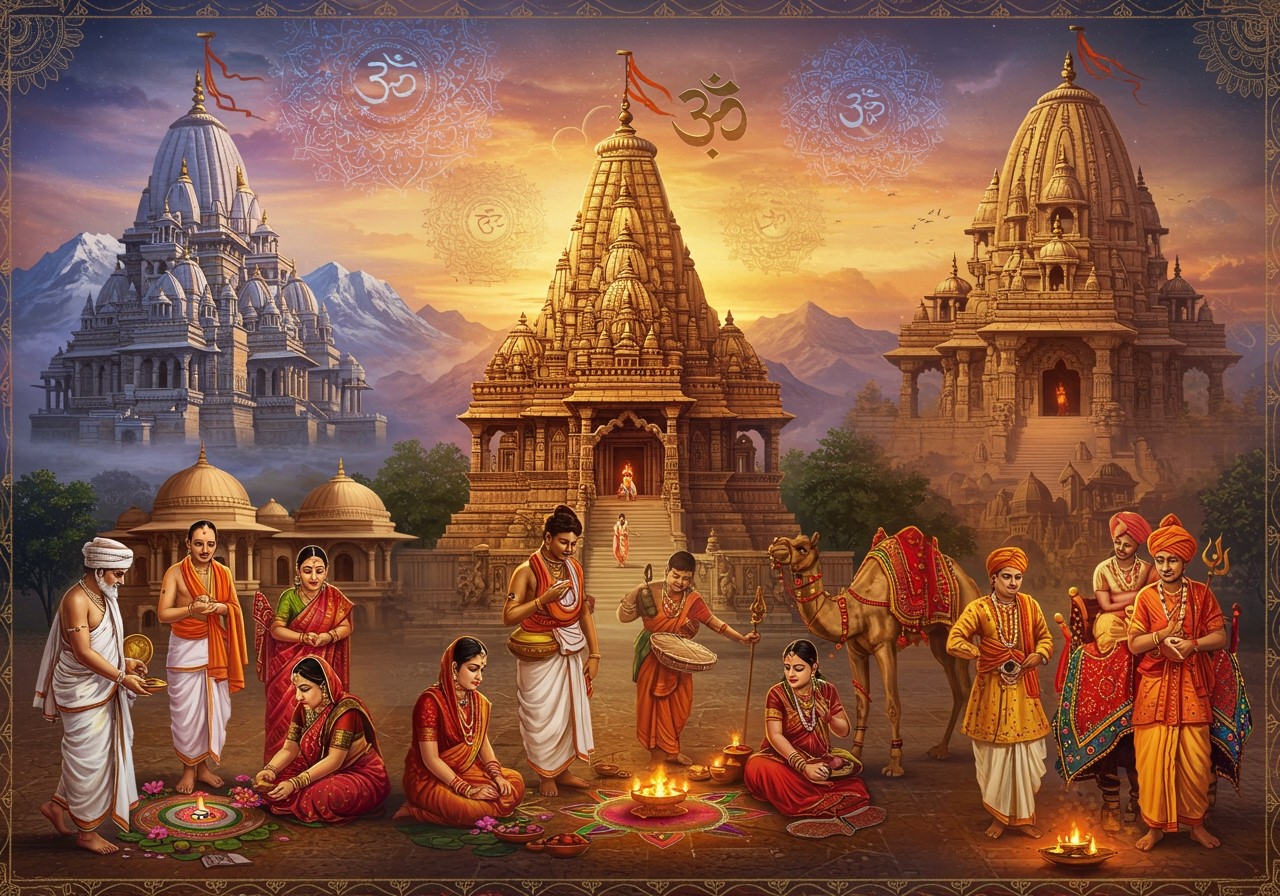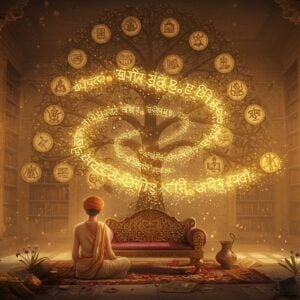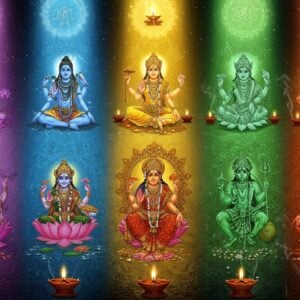
Hinduism, a vibrant faith deeply woven into India’s cultural fabric, isn’t a monolithic entity. Instead, it’s a beautiful mosaic of diverse beliefs, rituals, and practices that vary significantly across the country. Understanding these regional nuances offers a glimpse into how Hinduism adapts to different cultural landscapes, historical influences, and geographical contexts. This exploration is particularly relevant for those who cherish tradition and seek authentic ritual items, now easily accessible through the convenience of online shopping.
Regional Variations in Hindu Practices
South India: Here, Hinduism is characterized by magnificent Dravidian temple architecture, intricate carvings, and soaring gopurams. Temples aren’t merely places of worship; they are vibrant cultural centers. Festivals like Pongal in Tamil Nadu and Onam in Kerala celebrate harvests and regional folklore, adding to the rich tapestry of South Indian culture. Classical dance forms like Bharatanatyam and Kuchipudi serve as powerful expressions of religious devotion, narrating stories of gods and goddesses through graceful movements. The philosophical school of Advaita Vedanta, championed by Adi Shankaracharya, has deeply influenced the region’s spiritual thought. Ancestral reverence is another unique element, seamlessly integrated into the daily religious rituals of South India.
North-East India: In this region, Hinduism intermingles with indigenous tribal traditions and Buddhist influences, creating a unique spiritual landscape. Assam, for example, is a stronghold of Vaishnavism, largely due to the profound teachings of the saint-scholar Srimanta Sankardev. His legacy continues to resonate, forming the spiritual bedrock for many. Among communities like the Bodos and Meiteis, tribal beliefs harmoniously coexist with Hindu customs, resulting in a rich blend of traditions. Festivals like Bihu and Yaoshang beautifully exemplify this cultural fusion, commemorating both Hindu narratives and local celebrations. Architectural wonders such as the Kamakhya Temple in Guwahati stand as testaments to this diverse heritage. Nature worship and sacred groves hold a special place in local rituals, fostering a deep connection to the earth and emphasizing respect for the natural world.
A State-by-State Glimpse of Hinduism
Each state in India offers its own distinct interpretation of Hinduism, contributing to the faith’s incredible diversity. In Maharashtra, the Warkari movement thrives, characterized by devotional Abhangas (songs) that foster spiritual connection through music. Gujarat’s Navratri festival is a vibrant celebration of the divine feminine, showcasing influences from Jain traditions. Uttar Pradesh, home to the sacred Kumbh Mela and the ancient city of Varanasi, draws millions of pilgrims seeking spiritual enlightenment. West Bengal’s Durga Puja is a grand spectacle of art and devotion, while Rajasthan cherishes folk deities and narrative art forms like Pabuji ki Phad, highlighting the importance of storytelling in spiritual expression. Odisha’s Jagannath Yatra is a captivating procession, with the Puri temple serving as a major spiritual landmark. Himachal Pradesh reveres local deities known as ‘deotas,’ with festivals honoring these divine protectors.
- Maharashtra: The Warkari devotional movement, with its emphasis on Abhangas, is deeply ingrained in the state’s spiritual fabric. Pilgrimages to Pandharpur, dedicated to Lord Vitthal, are a central part of the Warkari tradition, drawing devotees from all walks of life.
- Gujarat: Navratri, celebrated with the vibrant Garba dance, is a major highlight. The festival’s energy and enthusiasm are infectious, bringing communities together in a joyous celebration of faith and culture.
Hinduism in the Modern Age
Hinduism’s regional variations have profoundly influenced Indian art, music, and literature for centuries. Today, these traditions are adapting to modern life through digital platforms. Virtual pujas and online access to ritual items make traditional practices more accessible globally. Hinduism plays a significant role in shaping regional identities and cultural pride, fostering unity amidst diversity. The challenge lies in preserving these traditions while embracing the conveniences of modern life. Families play a crucial role in transmitting this knowledge and upholding these rituals across generations. Tourism, while offering economic opportunities, also presents challenges in balancing preservation with accessibility as visitors explore India’s rich spiritual heritage.
Poojn.in: Your Gateway to Authentic Puja Items
For those seeking authentic puja items and religious goods, Poojn.in is your one-stop destination. We offer a wide selection of items for worshipping major deities like Lord Shiva, Lord Vishnu, Lord Brahma, Lord Krishna, and Lord Indra, recognizing the diverse ways they are revered across India’s regions. Whether you need a complete puja thali, specific offerings for Vaishnavite worship, traditional brass lamps, or specialized items for temple rituals, Poojn.in caters to every need.
For specific regional needs:
- North Indian Traditions: Find complete puja thalis, brass items, and specific offerings for Vaishnavite worship.
- South Indian Traditions: Explore traditional brass lamps, coconut holders, and items used in temple worship.
- East Indian Traditions: Access authentic Bengali puja essentials like dhak, shankha (conch), and Durga Puja items.
- West Indian Traditions: Discover items commonly used in Gujarati and Maharashtrian worship styles.
At Poojn.in, we ensure all our ritual items adhere to traditional specifications while offering the convenience of online shopping. Need guidance? Reach us at 03369029784 or WhatsApp us at 9476142738. We’re happy to help you find the perfect items for your regional customs. Explore our collection today and experience the ease of bringing tradition home.
Featured Products:
- Handcrafted Wooden Swashan Kali Mask: A unique piece for devotees seeking a powerful representation of the goddess.
- Handcrafted Wooden Kali Mask: A beautifully crafted mask for personal altars or ceremonial use.
Celebrating India’s Spiritual Richness
Hinduism in India is a vibrant tapestry woven with diverse threads of tradition. From the tribal influences of the North-East to the colorful festivals of Maharashtra and Gujarat, each region offers a unique lens through which to understand this ancient faith. These regional variations not only enrich India’s cultural heritage but also demonstrate the adaptability and resilience of Hindu traditions. In today’s digital age, we can connect with these practices from anywhere in the world, making rituals and authentic items accessible to all. This fusion of tradition and technology ensures that Hinduism remains a vital and evolving part of our lives. Let’s continue to explore and celebrate this diversity, honoring the wisdom passed down through generations while embracing the future with open hearts.
Understanding Regional Differences in Hinduism
Many wonder about the unique aspects of Hinduism across different states. It’s natural to be curious about how traditions vary and what makes each region’s practices special. Here are some common questions and insights:
South Indian Hinduism: Known for its stunning temple architecture, vibrant festivals like Pongal and Onam, and classical art forms like Bharatanatyam, South Indian Hinduism is a rich tapestry of tradition and devotion.
North-Eastern Hinduism: This region beautifully blends Hinduism with local tribal practices and Buddhist influences. Festivals like Durga Puja and Bihu showcase the unique cultural fusion of the area.
Bengali Hindu Traditions: The reverence for Goddess Durga, especially during the grand Durga Puja festival, is a cornerstone of Bengali Hindu traditions. A rich literary and musical heritage further enhances the region’s spiritual expression.
Gujarati Hindu Practices: Navratri, with its vibrant Garba dance, is central to Gujarati Hindu culture. The state also has a strong Vaishnavite tradition, particularly focused on Lord Krishna.
Hinduism Across States: The variations in Hindu practices across India stem from the country’s vast geographical and cultural diversity. Each region’s unique history, language, and cultural influences shape how Hinduism is observed and celebrated.
Learn more about Durga Puja celebrations and regional differences.
Explore the Maa Lankeswari Temple in Odisha.
Find a Holi Puja Guide with essential supplies and rituals.
Discover regional Holi traditions and celebrations across India.


